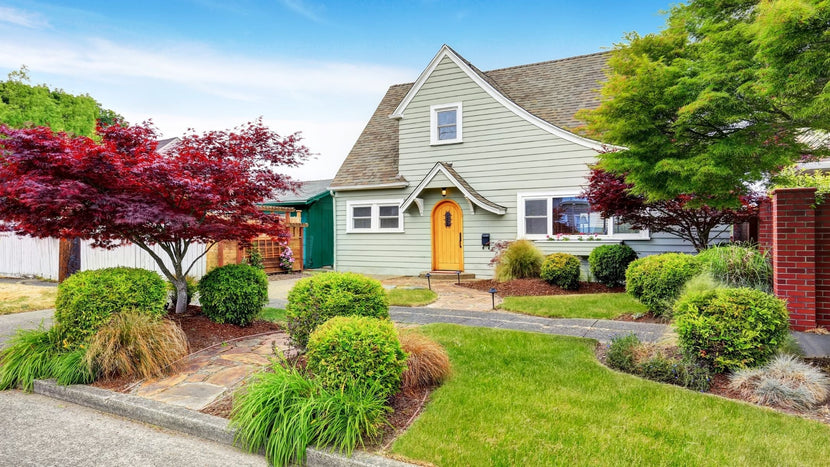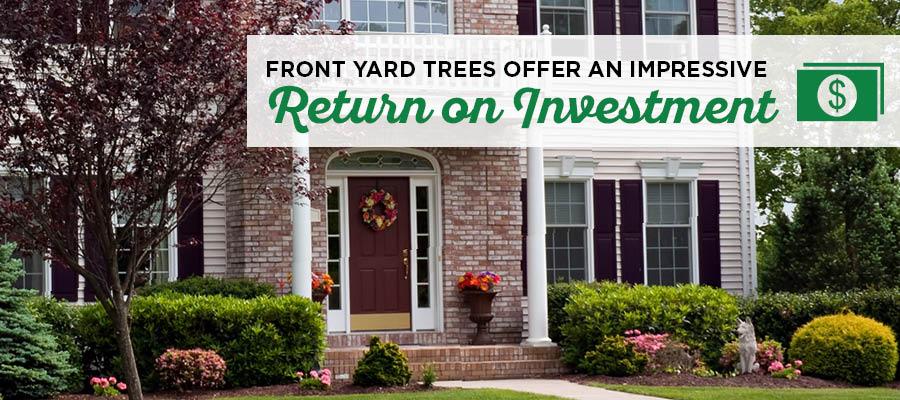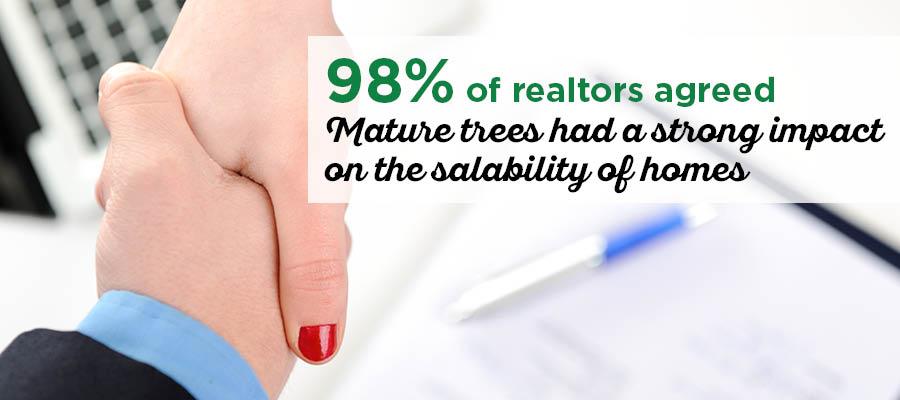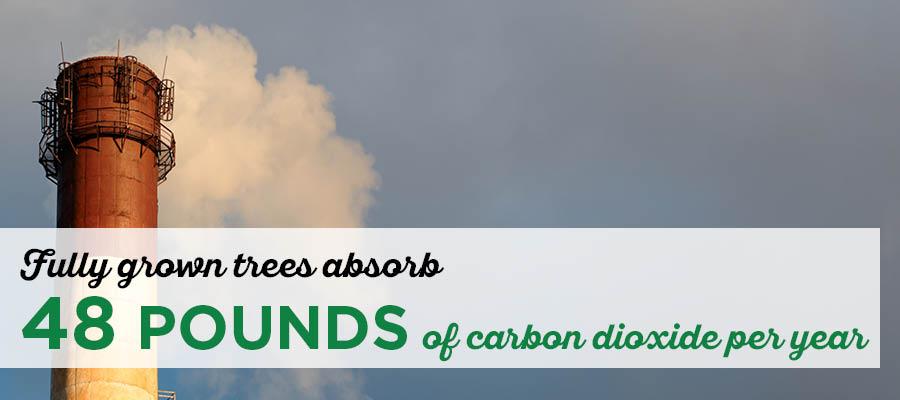
How to Choose Trees for Your Front Yard

There’s nothing like a mature tree to make a statement in your front yard. The right tree in the right location silently speaks to the most important task your home’s façade performs — creating a great first impression through captivating curb appeal. Planting the proper tree accomplishes this year round and for a lifetime ahead.
Front yard trees truly offer an impressive return on investment. Trees evoke positive emotions and trigger the senses. They provide beauty, shade and protection from the wind and the elements as well as cleaning the air and protecting the soil from erosion. That’s a lot to ask for, but trees have been doing this flawlessly for centuries.
It’s no wonder so many of America’s older neighborhoods have something in common. The wealthier sections of cities made tree planting a priority. Mature trees line boulevards and are positioned prominently in front yards. Majestic elms and oaks complement massive sequoias and decorative magnolias. Whether deciduous or evergreen, choosing the right tree has made these yards and streets magnificent.
Trees Increase Home Value
Choosing the best trees for your front yard accomplishes something more than decoration and environmental protection. By adding the right tree to your front yard, you’ll add value to your home and make your sale time quicker when you decide to sell your home. The curb appeal effect from planting good trees in the front yard is a major factor in closing a sale and receiving top dollar for your home.
This isn’t just speculation or wishful thinking. The National Arbor Day Foundation is a non-profit organization that is extremely knowledgeable on the subject of trees. The Arbor Day Foundation quotes the Council of Tree and Landscape Appraisers in reporting that a mature tree can be worth up to $10,000 in appraised value. They also quote the USDA Forest Service by saying that mature trees add an estimated 10% to overall property values.

It’s not just appraisers and foresters who recognize the value and return on investment through planting the best front yard trees. Management Information Services/ICMA reports that landscaping, especially with the right trees, can add as much as 20% to property values. Arbor National Mortgage & American Forests conducted a study and found that 98% of Realtors agreed that mature trees had a strong impact on the salability of homes.
Trees Provide Clean Air and Energy Savings

Trees provide an excellent return on investment by boosting curb appeal that raises property value and makes homes sell faster. But they also give a return on investment by offering natural energy efficiency. According to the USDA, healthy trees provide a net cooling effect that the equivalent of 10 room-sized air conditions operating for 20 hours per day. The Center for Urban Forest Research also states, “If you plant a tree today on the west side of your home, in 5 years your energy bills should be 3 percent less. In 15 years, that savings will increase to nearly 12 percent.”
That’s a lot of money in energy savings. It’s highly unlikely you can perform any better home improvement for energy efficiency than simply planting a tree.

Trees also help to retain ground water and prevent soil runoff. They clean the air, which is good for the environment and good for people. Trees take in carbon dioxide and give back oxygen. The State of Forests and Forestry reports that one fully-grown tree absorbs roughly 48 pounds of carbon dioxide per year. They also state that two adult trees provide approximately an entire year’s supply of oxygen for one person.
One front yard tree might seem like a small contributor compared to an acre of forest, but it can make a huge difference when it comes to your property.
However, it’s important to choose the right tree for your front yard. The difference between the right tree and the wrong tree could be the difference between if you’ll get that long-term return on investment or if you’ve just made a mistake you’ll regret. Fortunately, there is lots of helpful information available to help you pick the right tree for your yard.
Deciding on the Right Front Yard Tree
Deciding to plant a front yard tree is easy. There are tons of advantages but choosing the right tree can be challenging. The first thing to consider is what your goal is in planting a tree. Think about your new tree’s purpose. This purpose might include:
- Adding beauty to your landscaping
- Presenting a visual focal point
- Providing shade from direct sun
- Creating a break from prevailing winds
- Providing seasonal change through flowers and leaf color changes
- Allowing privacy and security
- Growing edible fruit and nuts
- Supporting birds, friendly insects and other wildlife
- Building a family legacy as a tribute to a passed-away loved one
Your tree’s purpose could be a combination of some or even all of these reasons. This is a personal decision and will be different for everyone. Once you’ve decided what you want from your new tree, it’s best to follow some simple steps. These steps will help you arrive at what will be your best choice for a front yard tree.
First, determine the exact location where you’ll plant your tree. This is crucial because your tree will live there for a long time. To ensure your proposed location is a good spot to plant a tree, it’s best to do a site analysis that considers elements like:
- Sun Patterns, Wind Direction and View Corridors: If you’re looking for shade, the south and southwest spots are best. For wind protection, your prevailing winds will likely be from the north and east. You’ll want to be sure not to obstruct your view of any nearby natural features like water or hills.
- Distance From Obstacles: Free-growing trees may infringe on overhead lines. Roots may obstruct underground utilities and drainage pipes. As your tree spreads out, it may touch the sides of structures.
- Relationship to Property Lines: Infringement on public or neighboring properties may pose a future liability as your tree matures and expands outside your boundaries. If your tree drops branches or even sheds leaves or needles on your neighbor’s property, this will be your responsibility.
- Existing Landscape Design: Remember that other plants will continue to grow and expand, especially trees. You want your new tree addition to work with your current landscaping, not against it. Try to envision how your tree will appear 5, 10 and 25 years in the future.
- Your Architectural Style: This is important since landscaping is just as much a part of home architecture as your house and outbuildings. Your home’s theme should extend from interior to exterior. The right choice of tree placed in the right location will add immeasurable value by accenting your architecture instead of clashing with it.
Working With Existing Conditions
Next, extend your site analysis into your location’s conditions. You need to choose a tree that fits and works with the natural conditions. Trying to change existing conditions to accommodate a specific tree species is difficult, not to mention expensive. It might even fail and kill your tree. Instead, it’s better to work with the conditions that already exist.
Take into account site conditions like:
- Hardiness Zone: The U.S. Department of Agriculture has identified different climatic zones across the country and rated them on a scale of 0 to 12. Zone 0 is known as permafrost and is not suitable for trees. Zone 12, on the other hand, designates year-round, frost-free sites like the deep south and some coastal areas. You can find your hardiness scale by entering your zip code on their website, or you can use the National Arbor Day’s Tree Wizard. It’s a free online tool that helps you make tree picking easy.
- Soil Composition: This is a crucial factor because some trees are incompatible with certain soils. It’s best to have a soil test done. This will identify if you have clay, sand or loamy soil. It also determines if your soil is acidic or alkaline through a pH test, and identifies nutrient deficiencies like nitrogen, phosphorous, potassium and trace mineral elements.
- Water Requirements: Certain tree species are drought-resistant, while others need their almost constant moisture. Irrigation can be installed in dry areas, but drainage in wet locations might be a challenge. Low areas in high precipitation regions will support the right tree if it’s properly chosen. Similarly, high spots with long, dry periods support suitable trees. It’s important to find out what the moisture content is in the spot you’ve chosen, and pick a suitable tree for that level of water.
- Light Availability: Observe the sun pattern where you’re planning on placing a new tree. Does the spot get full sun all day long? Is it shady most of the time? Or is it a blend of part shade and part sun? This will have an enormous effect on certain trees. The amount of light will also play a part in whether you decide on a deciduous tree that drops its leaves in the winter or an evergreen that blocks light all year long.
Deciding on the Best Trees to Plant in Your Front Yard
The next step is to make a short list. In this short list, you’ll identify what species will adapt and prosper in the hardiness zone you’re in and the spot you’ve picked to plant, and will complement your existing ground and other conditions. This can be the challenging part. It can also be the most fun part.
Let the National Arbor Day Foundation help guide you through the process. The non-profit foundation has an excellent website giving a vast amount of information on every type of tree available in America. We recommend using their free Tree Wizard online tool. It’s an amazing resource that removes the guess work and helps you narrow in on what are the best trees to plant in your front yard. Here’s how the Tree Wizard works.
- Step 1 — Enter your zip code. This determines your hardiness zone and starts eliminating trees that won’t grow in your area.
- Step 2 — Check off the trees types that interest you. Select from evergreens, deciduous, flowering, ornamental, fruit, nut, sun or shade. Check all that apply.
- Step 3 — List your growing conditions. For soil type you can click on acid, alkaline, clay, drought tolerant, loamy, moist, rich, sandy, silty, well-drained or wet. For sun exposure, choose from full, partial or shade.
- Step 4 — Enter your specifications such as height, spread width, shape and growth rate. Try to be specific and take a long-term perspective.
- Step 5 — Hit the calculation button and the Tree Wizard will hand you a list of the best trees to plant in your front yard. It’s comprehensive, accurate and entirely free.
Understanding Tree Types, Terminology and What to Look For
Before taking your short list to your nursery, spend a bit of time understanding the basic tree types, some tree terminology and what to look for when buying a tree. Familiarize yourself with basic planting techniques. Knowledgeable nursery staff members are going to be experts in the tree business. To get the most out of your visit to the nursery, it’s helpful to speak a bit of their language.
The basic tree types are evergreens and deciduous. Evergreens are usually large trees that keep their foliage all year long. They remain the same year round with few seasonal changes except for new springtime growth. Because evergreens block light year-round and are mostly unchanging, they’re normally used as side yard and backdrop trees. Their fast growth results in wide annual rings, giving them the term “softwoods.”
Deciduous trees tend to grow much slower than evergreens. This gives them tighter rings and the name “hardwoods.” Deciduous trees are far more popular for front yards due to the dramatic show they put on in the spring, summer and fall. During winter, deciduous trees go dormant and allow light to pass through their branches on short, darker days while their trunks and branches still provide wind protection.
Deciduous trees fall into five main categories:
- Shade trees that are dense with broad leaves
- Specimen or ornamental trees that have interesting foliage, bark and shapes
- Street trees that are large yet compact in height
- Windbreak and screening trees that are tall and grow tightly together
- Fruit trees that produce edible fruits and nuts
Trees have their own terminology and language. It’s helpful to know a bit of this tree language when talking to a nursery staff member who will help you make the final decision of your front yard tree. Here are some basic tree terms to help you get started:
- Family is the group that resembles each other in appearance.
- Genus is a group of species having fundamental characteristics in common.
- Species is a narrow band with similar traits but different appearances.
- Variety is a sub-group of species with small variations.
- Hybrids are cross-breeds of trees that don’t occur in nature.
- Clones are derived from one original tree by cultivating cuttings.
- Caliper is the tree trunk diameter.
Nursery trees are available in three planting conditions. This depends on the species of tree as well as its age. Nursery staff may have your tree available in these stages:
- Bare Root Seedlings: These are small and in the early growth stage. Good seedlings have moist, fibrous roots that are equal in length.
- Balled and Burlapped Plantings: These are a few years old and have their roots bound in a ball. Look for root balls that are firm, especially near the trunk.
- Potted or Containerized Trees: These trees are well established. Healthy specimens should not be root-bound with long circular roots that have no room to expand.
Professional nursery staff will assist you with more than just selecting the right tree species for your front yard. They’ll also help size your tree and ensure it’s healthy. Things to watch for in a healthy tree are:
- Bright, healthy bark that’s not damaged, wounded or scarred
- Trunks and branches that are insect-free and show no sign of disease
- Branches that are well-distributed around the trunk and considerably less diameter
- Branch spacing that is between 8 and 12 inches
- Good trunk taper
- Wide-angle crotches for branch strength.
Professional nursery staff will also give you planting tips. They’ll also give you tips on soil preparation, watering requirements and the importance of proper mulching. Nursery staff will also tell you what pruning is required and may demonstrate proper trimming techniques.
Garden Goods Direct sells high-quality trees and other plants that will help turn your front yard into the masterpiece it was meant to be. Visit Garden Goods Direct today to shop our online catalog and buy the right tree for your front yard.
